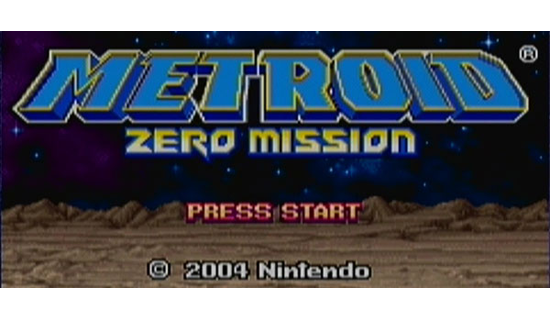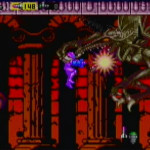Metroid was released on the Famicom Disk System and NES in 1986, and for its time it was a fantastic game. It practically invented a genre, and its influence on gaming in general simply cannot be denied. As the years passed and its sequels were released though (Metroid II in 1991 (US) and 1992 (Japan and Europe) on the Game Boy, and Super Metroid in 1994 on the Super Famicom/Super NES), the original quickly began to look and feel its age. It was Super Metroid in particular that really put it out to pasture, for all of the reasons that make it appear on many top SNES games lists. It just did everything that the original Metroid did, but orders of magnitude better. And it added something that the original was not too big on: Atmosphere.
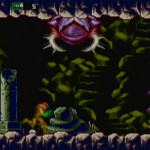 |  |
| Some sort of giant worm, the game’s earliest mini boss and brand new addition. | Mother Brain is watching you! |
Fast forward to 2002, just about 8 years after the release of Super Metroid. After lying dormant for some time, the series had just seen a revival in the simultaneous release (in the US anyway, nearly simultaneous in Japan) of Metroid Fusion on the Game Boy Advance (which was a more classically inspired, Nintendo developed Metroid game) and Metroid Prime (the Western developed first-person adventure that would be the new direction of the Metroid series for awhile). So needless to say, Metroid popularity was back in full swing again. When working on Metroid Fusion, ideas were already being thrown around as to what the next Nintendo developed Metroid game should be. Since Retro Studios was the star of the console Metroid world, it probably made the most sense to keep the Nintendo Metroid games on a portable platform. The DS wouldn’t be launched until the end of 2004, and since this game was announced in 2003 it probably didn’t make any sense to wait that long. That left making another Game Boy Advance title.
The Game Boy Advance was home to many Super Famicom/Super NES ports, so the obvious thing to do would be to simply port Super Metroid over to the GBA and call it a day. Everyone loved Super Metroid after all, so it could be a mini renaissance for the beloved title. Yoshio Sakamoto, the man who had directed every Nintendo developed Metroid (save for Metroid II) up until this point, had other ideas though. Metroid Fusion, though inspired by the classic Metroid games, felt different from its predecessors in many ways. Sakamoto wanted to return to the roots of the Metroid series for the next installment, showing players who had just come into the series where Metroid came from. And since he was the man behind the original Metroid, what better point to return to than the very beginning? It would not be a port of Metroid (at this point Nintendo probably knew that they were planning on releasing the Famicom Mini/Classic NES series as they gave the GBA its grand sendoff, and the original Metroid would be a part of that series. Though maybe not, since the original is an unlock-able for beating Zero Mission), but rather a re-imagining that was incredibly faithful to what made that original game great.
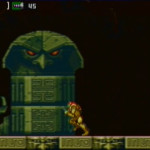 |  |
| The detail in some of the background scenery is really quite amazing in parts. | Kraid is back, in all his Super Metroid-y glory! |
They already had an engine to use from Fusion, and they already had the original Metroid’s plot. Sakamoto wanted to focus not only on re-telling the story of Samus’ very first mission, but also on her back story. However one hallmark of the pre-Fusion Metroid games is that they told a story using barely any to no words whatsoever. That meant that in order to appeal to the players who may have come into the series with Fusion, a little bit more exposition would needed to make things feel more interesting. This resulted in the introduction of another means of story telling: Cut scenes.
I can almost hear the groans coming from fans of the older Metroid games. An exposition-filled remake of the original Metroid did sound like it could go very wrong, however there was no reason to fear. A very minimal amount of text-based story telling and narration was added, appearing only in a few spots throughout the game. The cut scenes were a bit strange at first, but they did end up lending a bit of atmosphere that may not have been there otherwise. Visual clues were also added on the map to indicate where your next destination to advance the story will be. Nothing about this makes the game significantly easier though, and you can still explore to your heart’s content. A difficulty level can also be selected before starting a new game, which at this point was a series first.
Everything else about this game, from the visuals to the sound design, is a complete Super Metroid-ification of the original, and that’s not a bad thing. Super Metroid oozed atmosphere, and that same feeling comes through in Zero Mission. With that comes all of the wonderful control intricacies of Super Metroid as well, down to Speed Boosting and Shine Sparking. The map layout and flow of the game bare some resemblance to the original, but it is heavily modified with new power-ups, mini bosses, and even an entire new area after Mother Brain.
That’s right, after you beat Mother Brain the game is not over! An entirely new area called Chozodia has been added, and most of it is played through as Zero Suit Samus (in her very first appearance). Samus is basically helpless against the space pirates, forcing the player to stun them and run away. While it is a rather annoying thing to get used to for seasoned Metroid fans, exploring the idea of how Samus might get by without her suit is interesting. It could be that some survival horror elements were being channeled here as well. Either way, this is the worst part of the game, and probably did not actually need to be here.
The Japanese TV commercials for Zero Mission featured Japanese idol/actress Chisato Morishita in Zero Suit Samus costume, prominently featuring this new part of the game:
 | 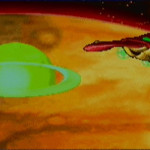 |
| And here’s Mother Brain, complete with creepy eye! | Samus’ ship during the escape scene. The cut scene graphics do look quite nice! |
Metroid: Zero Mission also marks a sad occasion: The dissolving of Nintendo’s R&D 1 team. They were an internal development team originally headed by the great Gunpei Yokoi, and were responsible for not only all of the Nintendo Metroid titles, but also the Super Mario Land series, Kid Icarus, Mario Paint, Panel de Pon and the Wario Land and WarioWare series. Though many of the former R&D 1 members can be found on the SPD team, it doesn’t feel quite the same. R&D 1 were responsible for just about all of Nintendo’s quirky and off-kilter content, but at least they went out one a fine game.
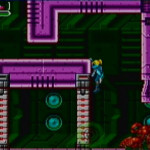 | 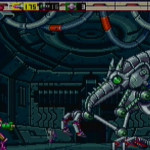 |
| You’re Zero Suit Samus in most of Zero Mission’s new scenario, and most of the time you’ll be running away from these guys! | Crow T. Ridley, everyone! |
Metroid: Zero Mission is one of the finest games available on the Game Boy Advance. Some might say that it’s too short, but to those I’d ask: Have you ever played a Metroid game before? They’re usually able to be completed within a small handful of hours, particularly the original. This falls just under Super Metroid in terms of being exactly what a Metroid game should be, and has the added benefit of being portable. While the original Metroid will always remain an important historical piece, Zero Mission easily replaces it as the definitive way to experience how the series began.
